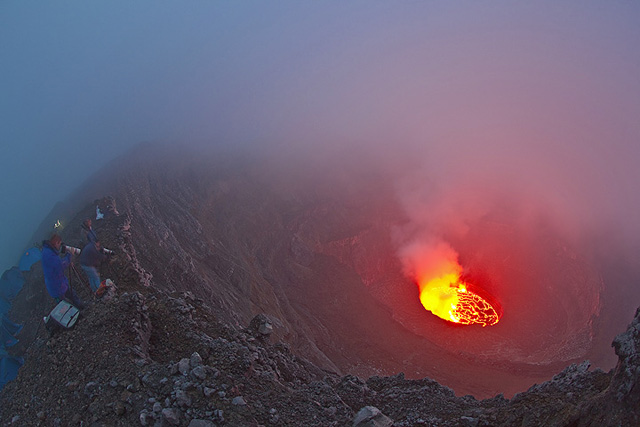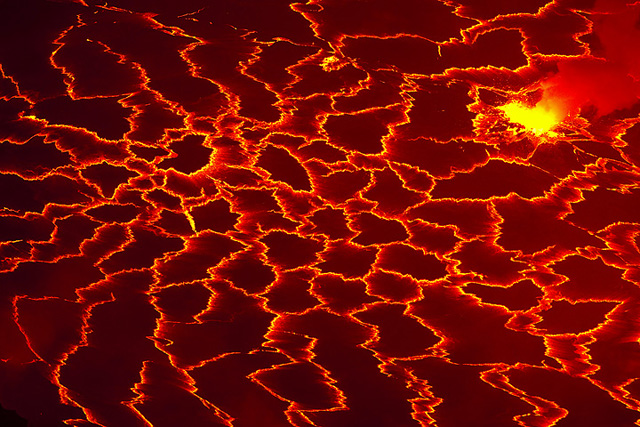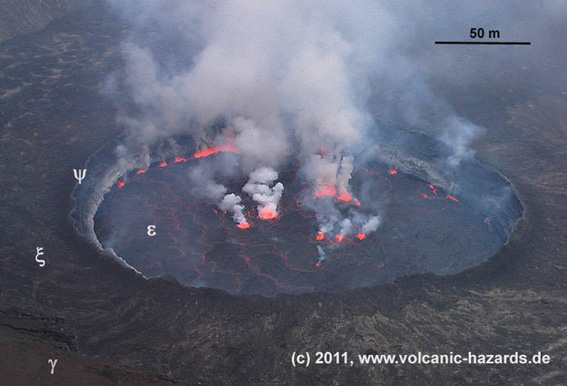Report on Nyiragongo (DR Congo) — December 2012
Bulletin of the Global Volcanism Network, vol. 37, no. 12 (December 2012)
Managing Editor: Richard Wunderman.
Edited by Jen Fela.
Nyiragongo (DR Congo) Bubbling lava lake visited by three groups during January 2011
Please cite this report as:
Global Volcanism Program, 2012. Report on Nyiragongo (DR Congo) (Fela, J., and Wunderman, R., eds.). Bulletin of the Global Volcanism Network, 37:12. Smithsonian Institution. https://doi.org/10.5479/si.GVP.BGVN201212-223030
Nyiragongo
DR Congo
1.52°S, 29.25°E; summit elev. 3470 m
All times are local (unless otherwise noted)
This report discusses observations of Nyiragongo made in January 2011. As noted in BGVN 35:09, a 14-24 June 2010 expedition into the crater showed that Nyiragongo's lava lake was continuously active and had risen since the last extensive eruption that inundated central Goma in January 2002.
Similar activity was confirmed during visits by three groups to the crater during 9-12 January, 16-26 January, and 20-23 January 2011, with observations of a continuously active lava lake, lava fountains reaching several meters high, and gas emissions (figures 48 and 49; dozens more images appear on the websites noted in the Information Contacts subsection). One group described the lava lake as "boiling so lively and quick-tempered, like cream of wheat in a pot at the highest heat setting."
On 20 January 2011, the topography of the interior of the crater remained the same as in mid-June 2010 (figure 50). The surface of the lava lake was then between 3,010 m and 3,020 m elevation. Convection of the lava lake surface and disruptions in the cooled surface that produced fountains and gas emissions were observed at differing intensities. The symbols in figure 50 correspond to those of figure 45 in our previous report, thus preserving terminology (BGVN 35:09). The observers recognized three upper terraces from the previous figure (α, β, and γ) but not all are visible in figure 50.
Geological Summary. The Nyiragongo stratovolcano contained a lava lake in its deep summit crater that was active for half a century before draining catastrophically through its outer flanks in 1977. The steep slopes contrast to the low profile of its neighboring shield volcano, Nyamuragira. Benches in the steep-walled, 1.2-km-wide summit crater mark levels of former lava lakes, which have been observed since the late-19th century. Two older stratovolcanoes, Baruta and Shaheru, are partially overlapped by Nyiragongo on the north and south. About 100 cones are located primarily along radial fissures south of Shaheru, east of the summit, and along a NE-SW zone extending as far as Lake Kivu. Many cones are buried by voluminous lava flows that extend long distances down the flanks, which is characterized by the eruption of foiditic rocks. The extremely fluid 1977 lava flows caused many fatalities, as did lava flows that inundated portions of the major city of Goma in January 2002.
Information Contacts: Tom Pfeiffer, Volcano Discovery (URL: http://www.volcanodiscovery.com/); Marc Szeglat, Vulkane.net (URL: http://vulkane.net/); Christoph Weber, VHDL, Muehlweg 11, 74199 Untergruppenbach, Germany (URL: http://www.volcanic-hazards.de/).




